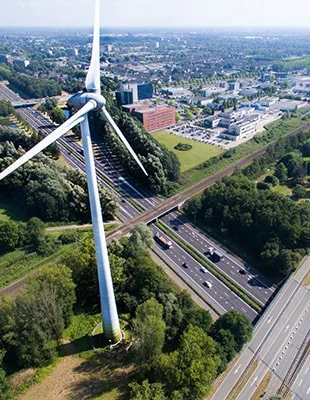Reducing your business’ carbon footprint can feel complex, but with Arcadis as your guide and partner, streamlining this process becomes achievable. Learn how our experts can help you cut carbon emissions with a comprehensive decarbonization roadmap.
Individuals, companies, buildings and industrial sites worldwide face the challenge of cutting carbon emissions amid rising global warming concerns. Only two out of five scenarios from the Intergovernmental Panel on Climate Change (IPCC) offer a chance to meet the targets set by the Paris Agreement to limit the rise in temperatures. This calls for immediate, unified action to achieve these necessary reductions.
New legislations are driving change
To address these challenges, various international regulations such as the EU Green Deal have been set in motion, with programs such as Fit for 55 and the EU Emissions Trading Systems. These regulations are being integrated into regional laws, shaping the regulatory landscape as we’re seeing in Flanders, Brussels and Wallonia.
The imperative to enhance energy efficiency and reduce carbon footprints is not only a matter of responsibility but now also a legal requirement due to the increasingly stringent regulations in place.
Where to start?
Arcadis can help you understand how energy is used on your site and find the primary sources of carbon emissions. Our carbon reduction roadmap begins with a thorough site assessment, from building structures to operational processes.
This evaluation provides insights into energy consumption patterns, emission sources and improvement opportunities, setting the baseline for a ‘business as usual’ scenario. This way, you can gain a better understanding of how much CO2 your site might produce in the future, taking various important factors into account.
Prioritized action plan
The next step involves determining the level of effort needed to meet objectives or identifying feasible reductions within various constraints. This involves collaborative brainstorming with stakeholders to ensure diversity in perspectives and maximize engagement and positive outcomes.
After this phase, a series of measures is identified — ranging from building upgrades to process adjustments, renewable energy adoption and waste heat recovery implementation. Prioritizing these measures involves a qualitative analysis based on predefined criteria such as emission impact, costs and operational feasibility.
Each criterion is assigned a specific weight to indicate its importance, and each measure is scored against these criteria through objective analysis and the expertise of our team. This results in a prioritized list that steers stakeholders toward the most effective strategies.
A roadmap to guide you
The chosen measures are then integrated into various scenarios or ‘roadmaps,’ each designed to achieve CO2 reduction targets. Potential overlaps and clashes among these measures are assessed to develop practical scenarios, taking into account factors like financial impact and timeframes for implementation. Through discussions and refinements with stakeholders, the final carbon reduction plan is tailored to fit specific needs and goals.
Our biggest differentiator
While most carbon reduction roadmaps typically focus only on Scope 1 and 2 emissions, our experts at Arcadis go further by including broader aspects like life cycle assessments and biodiversity assessments. By expanding the scope, our roadmaps evolve into sustainability roadmaps, offering a holistic view of measures that extend beyond carbon reduction, fostering a more sustainable future.
Get in touch with Mathieu Duhoux to start your sustainability journey.





